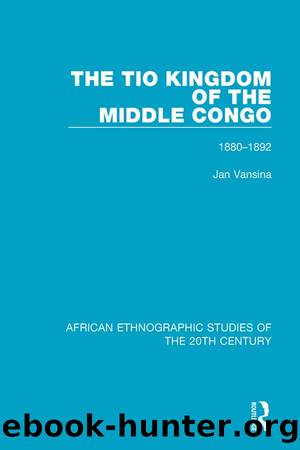The Tio Kingdom of The Middle Congo by Jan Vansina

Author:Jan Vansina [Vansina, Jan]
Language: eng
Format: epub
Tags: Social Science, Ethnic Studies, African Studies, Anthropology, General
ISBN: 9780429941399
Google: OxBqDwAAQBAJ
Publisher: Routledge
Published: 2018-09-03T03:40:22+00:00
Chapter XI
The Commercial Economy
TO examine the sort of commercial economy that existed among the Tio at this time, it is essential to discuss successively the currencies used, the prices, the volume of the trade, and the role of Tio traders in it before its major features can be perceived. The chapter will conclude with a brief sketch of the impact of this commercial system on Tio society.
1. Currencies
The market at the Pool dictated which currencies were acceptable to the Tio over their whole territory. By 1880 these included a copper unit, the brass rod: mi-tako, (Sims: litoo) a cloth unit, the ibuunu for imported cloth and the ntaa for raphia cloth, the nji which was the olivancillaria nana shell and perhaps still a lead ingot. The situation was dynamic however and within a few years after 1881 the mitako had supplanted all other currencies as a standard of value. Payments could be made with these currencies or objects might be bartered directly once their value had been assessed in terms of currency. This implied that there were ratios of value between one currency and another. Only foodstuffs could not be acquired, at least in 1882, by barter but had to be paid for in currency. There were often relative shortages of these, and they were essential for survival which may explain their special status. To account for this by arguing that their low value per unit made them difficult to exchange, seems less convincing.1
Lead ingots, stated Bentley, who arrived early in 1881, were at one time indispensable for the purchase of ivory at the Pool. Ingots of lead and copper ingots arrived there from the Nsama mines which he situated sixty miles north-west of the Manianga market.2 They had lost out completely to other currencies well before 1881. Copper rods from the same area came to the Tio probably directly via the Laadi. From the mines they also came to the Pool where they were resold to the Bobangi. They are described by Mahieu as being cylindrical, thick as the little finger, and one inch or so long. The Bobangi and the Tio also used another copper rod, half an inch in diameter and three inches long and bent at the ends, which was molten in Manianga. These were and are called ngiele by the Tio and were used as currency before the brass rod (mitako) replaced them. De Chavannes made it three and a half inches long at Mfwa with a circular section of one square centimetre, (little less than half an inch). By 1880 the first type of one inch was still in use among the âBangalaâ, but they were replaced by mitako as soon as the Europeans arrived. At the Pool itself they were ousted before 1881.3
Nji means now âmoneyâ or any currency in Tio, but it specifically referred to olivancillaria nana, often called nzi mbuli at the Pool,4 which the Tio on the plains called mbula for the larger shell and nji for the abstract notion of money, as well as for the smaller among the olivancillaria shells.
Download
This site does not store any files on its server. We only index and link to content provided by other sites. Please contact the content providers to delete copyright contents if any and email us, we'll remove relevant links or contents immediately.
Man-made Catastrophes and Risk Information Concealment by Dmitry Chernov & Didier Sornette(5650)
The Revenge of Geography: What the Map Tells Us About Coming Conflicts and the Battle Against Fate by Kaplan Robert D(3961)
Zero Waste Home by Bea Johnson(3655)
In a Sunburned Country by Bill Bryson(3368)
COSMOS by Carl Sagan(3348)
Good by S. Walden(3347)
The Fate of Rome: Climate, Disease, and the End of an Empire (The Princeton History of the Ancient World) by Kyle Harper(2873)
Camino Island by John Grisham(2719)
A Wilder Time by William E. Glassley(2690)
Organic Mushroom Farming and Mycoremediation by Tradd Cotter(2567)
The Ogre by Doug Scott(2501)
Human Dynamics Research in Smart and Connected Communities by Shih-Lung Shaw & Daniel Sui(2431)
Energy Myths and Realities by Vaclav Smil(2380)
The Traveler's Gift by Andy Andrews(2299)
9781803241661-PYTHON FOR ARCGIS PRO by Unknown(2269)
Inside the Middle East by Avi Melamed(2230)
Birds of New Guinea by Pratt Thane K.; Beehler Bruce M.; Anderton John C(2175)
A History of Warfare by John Keegan(2105)
Ultimate Navigation Manual by Lyle Brotherton(2048)
